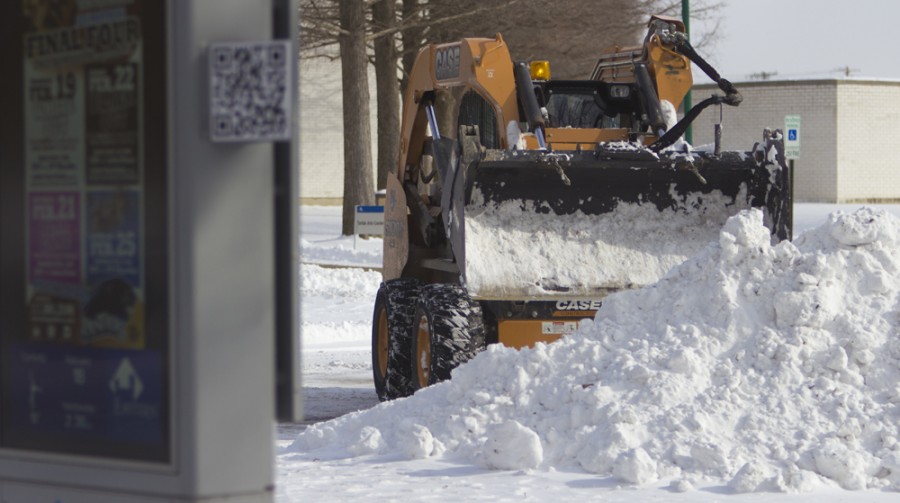Police advise caution with freezing weather
An Eastern groundskeeper uses a skid steer to plow snow on Wednesday near Buzzard Hall. According to the National Weather Service, temperatures are expected to reach a high of 8 degrees and drop to 2 degrees below zero. The high on friday is exptected to be 21 degrees with a 30 percent chance of snow.
February 19, 2015
As temperatures continue to drop below freezing, police recommend for students and community members to take extra weather safety precautions.
The Coles County Police Department issued a wind chill advisory warning residents to take measures to bundle up and stay warm.
Lt. Brad Oyer, of the Charleston Police Department, said residents should make a conscious effort to stay updated on the forecast, with Illinois having abrupt changes.
“The weather could be in the 50s one day, and in the negative the next,” he said. “It can catch you by surprise.”
However, Charleston’s weather has stayed consistently at or below freezing, with a week-high temperature of 33 degrees Saturday.
For the majority of the week, lows have dropped to single or negative degrees, retaining all snow recently accumulated.
Wind chill, which is the effect wind has on the actual temperature, causes room for concern. Thursday’s temperatures are expected to take a dive with a wind chill of between minus 12 to minus 22 degrees, according to the national weather service.
That coupled with wind gusts at 17 mph elevates risk of frostbite. If skin is exposed for longer than 30 minutes, there could be a potential for frostbite.
While the potential for frostbite is still there, bundling up before walking out into the cold will greatly reduce chances of frostbite. Bundling up includes wearing thick socks and gloves, along with the coat. Extremities are more susceptible to frostbite.
Kate Arsenault, a senior communication studies major, said she felt these effects.
She said during a 10-minute walk from her apartment to campus, her bare hands went numb.
“They turned bright red,” she said.
To counteract the numbness, she said she bought a cup of coffee to use as a hand warmer.
“I had to make a stop halfway to the Union,” she said. “The coffee was used to warm my hands more than anything.”
Oyer said planning ahead is necessary for the cold weather.
“Don’t wear a light jacket thinking that you’re just walking a short distance to your car,” he said. “Wear a heavy coat. You cannot predict car trouble and you may be waiting a while before help gets to you.”
Along with a heavy coat, a winter-ready car should have a blanket or two, a small storage of extra food, sandbags to properly distribute weight and a snow shovel, Oyer said.
“You don’t need to pack a picnic, but have some candy bars or granola bars handy,” he said.
Oyer said taking time in all stages of driving will best ensure the safety of drivers and pedestrians, including clearing off the entire vehicle when preparing to drive.
“You always see that person who clears off a little spot, just enough to see straight ahead,” he said. “You need all windows cleared to see traffic.”
Pedestrians should be as cautious as drivers when there are dangerous road conditions.
Oyer said to not lose focus by texting or by listening to music with earbuds.
“Vehicles may slide, watch what is going on,” he said.
Despite the more hazardous road conditions, Oyer said he was not aware of a greater number of car accidents.
“Luckily, people are used to Illinois weather and driving in it,” he said.
Jarad Jarmon contributed to this article.
Megan Ivey can be reached at 581-2812 or [email protected].





















































